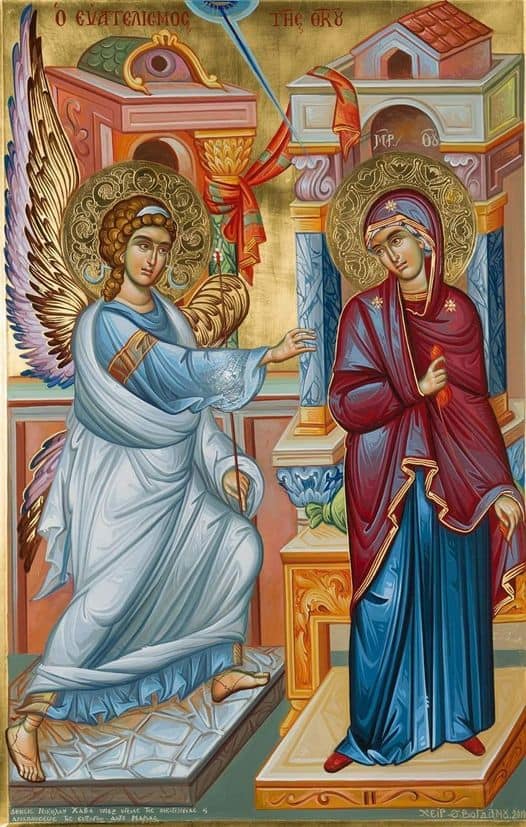Celebrating the Annunciation on April 7 – The Day Heaven Met Earth
Every year on April 7, Orthodox Christians celebrate one of the most profound events in salvation history—the Annunciation of the Theotokos. This sacred feast commemorates the moment the Archangel Gabriel appeared to the Virgin Mary, announcing that she would bear the Son of God.
But this was no ordinary message—it was the turning point in God’s plan for humanity’s redemption. The Annunciation marks the incarnation of Christ, the divine Word taking on human flesh. And at the heart of this miracle was Mary’s free and faithful “yes” to God’s will.
In this blog post, we’ll explore:
✔ The biblical story of the Annunciation
✔ The deep theological meaning behind this feast
✔ The symbolism in the stunning Orthodox iconography
✔ How the Church celebrates this miraculous event
The Biblical Story: When an Angel Brought Heaven’s Greatest News
The Annunciation narrative comes from Luke 1:26-39, where the Archangel Gabriel visits a young woman in Nazareth named Mary. His greeting was extraordinary:
“Hail, O favored one, the Lord is with you!” (Luke 1:28)
Mary was troubled—who wouldn’t be? An angel suddenly appears, calling her “favored” by God! Gabriel reassures her:
“Do not be afraid, Mary, for you have found favor with God. And behold, you will conceive in your womb and bear a son, and you shall call his name Jesus.” (Luke 1:30-31)
Mary’s response reveals her humility and wisdom:
“How can this be, since I have no husband?” (Luke 1:34)
Gabriel explains that this will be a miraculous conception by the Holy Spirit, and the child will be the Son of God. As a sign, he tells her that her elderly cousin Elizabeth (mother of John the Baptist) is also pregnant—because “nothing is impossible with God.”
Mary’s answer changed history:
“Behold, I am the handmaid of the Lord; let it be to me according to your word.” (Luke 1:38)
With these words, she became the living Ark of the New Covenant, the vessel through which God entered the world.

Why the Annunciation Matters: Divine Initiative Meets Human Freedom
The Annunciation isn’t just about God’s action—it’s also about Mary’s choice. Unlike Eve, who disobeyed God, Mary willingly cooperated with His plan.
God did not force her—He waited for her consent.
She could have refused, but her faith and obedience opened the way for salvation.
This shows that God respects human freedom—He invites, but never overrides, our will.
This is why the Orthodox Church honors Mary as the Theotokos (God-bearer)—not just because God chose her, but because she chose Him back.
The Icon of the Annunciation: A Masterpiece of Divine Symbolism
Orthodox icons of the Annunciation are bursting with theological meaning. Let’s break down the key elements:
1. The Archangel Gabriel – The Messenger of Good News
His feet are dynamic, as if running to deliver heaven’s message.
In his left hand, a staff—symbolizing his role as God’s messenger.
His right hand extended in blessing, announcing God’s favor.
2. The Virgin Mary – The Humble Servant Who Said “Yes”
She sits on an elevated seat, showing her exalted role as Mother of God.
In her left hand, a spindle of scarlet yarn—a reference to her weaving the Temple veil (symbolizing Christ’s flesh as the new Temple).
Her right hand raised in acceptance—her free surrender to God’s will.
Three stars on her garments, representing her perpetual virginity (before, during, and after Christ’s birth).
3. The Divine Realm – The Holy Spirit Descends
At the top, a segment of a circle with rays—symbolizing the Holy Spirit overshadowing Mary.
This moment marks the divine conception of Christ—God becoming man.
How the Orthodox Church Celebrates the Annunciation
The feast is celebrated with Great Vespers the evening before and the Divine Liturgy of St. John Chrysostom on the day itself. Key Scripture readings include:
Genesis 28:10-17 (Jacob’s Ladder—a foreshadowing of the Incarnation)
Ezekiel 43:27—44:4 (The Temple gate through which only the Lord enters)
Luke 1:24-38 (The Annunciation narrative)
This feast is so significant that even during Lent, the fast is relaxed to allow fish, wine, and oil in celebration!
Final Thoughts: The Annunciation – A Feast of Hope and Surrender
The Annunciation isn’t just a historical event—it’s a living mystery that invites us to respond as Mary did:
Will we say “yes” to God’s will, even when it seems impossible?
Will we trust Him, even when His plans are beyond our understanding?
Mary’s faithful obedience brought salvation into the world. And today, we are called to do the same—to bear Christ in our hearts and lives.
Happy Feast of the Annunciation! 🌿✨
